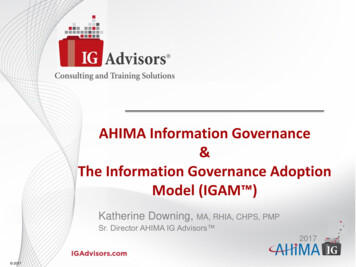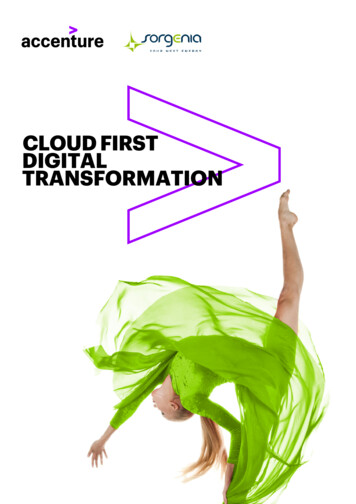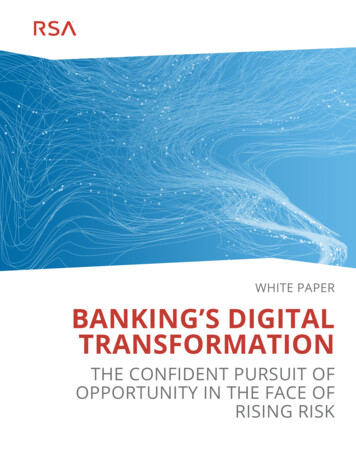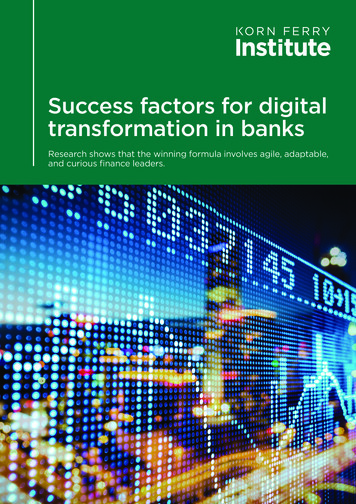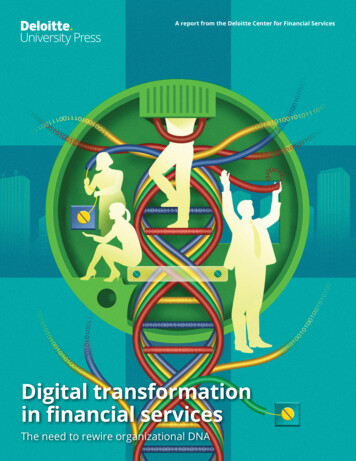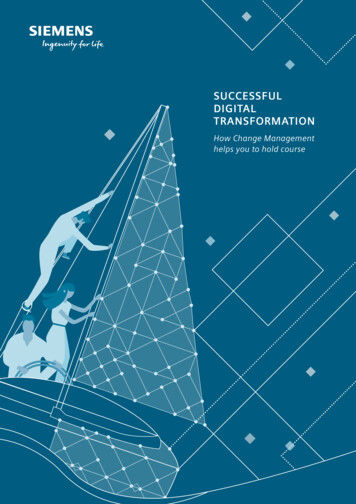
Transcription
IT GOVERNANCE IN DIGITAL TRANSFORMATIONA COBIT 5 overview according IDC MaturityscapeAna Catarina Saldanha JerónimoDissertation as requirement for obtaining the Master’sdegree in Information Managementi
ii
NOVA Information Management SchoolInstituto Superior de Estatística e Gestão de InformaçãoUniversidade Nova de LisboaIT GOVERNANCE IN DIGITAL TRANSFORMATIONA COBIT 5 overview according IDC MaturityscapebyAna Catarina Saldanha JerónimoDissertation as a requirement for obtaining the Master’s degree in InformationManagement, with specialization in Information Systems and Technologies Management.Advisor: Professor Vitor Duarte dos SantosNovember 2018iii
ACKNOWLEDGEMENTSI would like to thank to my thesis advisor Professor Vitor Duarte dos Santos of the NovaInformation Management School at Universidade Nova de Lisboa, for the continuousorientation and the construction criticism that allowed the study evolution.I would also like to thank to Bruno Horta Soares of IDC for the advices and comments givento this study, which were really important to improve the work and understand the vision ofsomeone expert in those frameworks.A special thanks to my family for all the support that was needed thru all this process.iv
ABSTRACTWe live in an era where digital transformation is highly increasing, gaining a new importanceto the company’s business. This digital transformation introduces an all new paradigm wherecompanies have to adapt to be more competitive, more costumer related, allowing them topresent new solutions and new business models.When implementing this kind of changes, companies must pay attention to the ITGovernance to help them align the IT strategy with the company and the stakeholder’sstrategy and goals.The motivation and objective of this thesis is to understand how COBIT5 can help to achievea higher digital transformation maturity .This study presents a matrix of the different dimensions of the IDC digital transformationmaturity matrix and relate them with the COBIT5 procedures, helping the organizationsachieve a better maturity in a certain dimension.This matrix can be used as a guide for organizations dealing with digital transformation, thatafter understanding their maturity level on a specific dimension, search assistance tounderstand what changes to implement to achieve a higher maturity level.KEYWORDSCompany strategy, New IT, Governance frameworks, best practices, maturity matix,procedures.v
Index1.1. Background . 11.2. Motivation, objectives and study relevance . 22. Literature Review . 42.1. IT Governance. 42.1.1. Concepts . 42.1.2. Benefits . 42.1.3. Frameworks . 52.1.4. COBIT 5 . 62.2. Digital Transformation. 222.2.1. Concepts . 222.2.2. Main Areas. 232.2.3. IT Governance in Digital transformation . 242.3. IDC Maturity Matrix . 252.3.1. Concept. 252.3.2. Maturity Scape Stages . 262.3.3. Maturity Scape dimensions . 263. Methodology . 303.1. Design Science Research . 303.2. Investigation Strategy . 314. Building a Framework . 324.1. Assumptions . 324.2. Framework. 334.3. Discussion and analysis . 465. ConcLusion. 505.1. Summary of the developed work . 505.2. Limitations . 505.3. Future Work. 51References . 52vi
LIST OF ABBREVIATIONS AND ACRONYMSDSRDesign Science ResearchIDCInternational Data CorporationISInformation SystemsITInformation technologyITDGIT demand governanceITGIT GovernanceITRGIT-Related GoalsROIReturn on investmentvii
FIGURESFigure 1 - IT Governance Frameworks (Larsen & Andersen, 2006) . 5Figure 2 - COBIT 5 - Priciples (ISACA, 2012b) . 6Figure 3 - COBIT 5 - Circle of life of the implementation (ISACA, 2012b) . 8Figure 4 - COBIT 5 - Processes of Governance of Enterprise IT (ISACA, 2012b). 9Figure 5 - COBIT 5 - IT Processes objectives (ISACA, 2012a) . 12Figure 6 - Evolution of digital transformation (Tannou & Westerman, 2017) . 22Figure 7 - 3rd Platform of Digital Transformation (Magee, 2016) . 23Figure 8 - IDC MaturityScape stages (Holly Muscolino, 2017) . 26viii
TABLESTable 1 - IT Related Goal and Metrics provided by COBIT5 (ISACA, 2012a) . 11Table 2 - COBIT 5 ITRG relation to the IDC matrix dimensions . 33Table 3 - COBIT 5 governance practices to suport the digital transformation - Leadership . 35Table 4 - COBIT 5 governance practices to suport the digital transformation – Omniexperience . 38Table 5 - COBIT 5 governance practices to suport the digital transformation – Talent Hiring. 40Table 6 - COBIT 5 governance practices to suport the digital transformation – OperationalModel . 42Table 7 - COBIT 5 governance practices to suport the digital transformation – Information 45ix
INTRODUCTION1.1. BACKGROUNDIn the last few years there was a great change in the Information Systems. With the quick evolutionof the new technologies it is imperative that organizations adapt in order to be competitive. Subjectslike cloud, mobility, artificial intelligence come directly in to our lives. With the unlimited access tothe internet and, as a result the access to an enormous amount of information, clients gain a newfreedom and knowledge that was not possible before, this makes them the most exigent clients tillnow (Vey, n.d.). They also have access to new ways of making business (consumer to consumer) andhave access to all the organization offers anytime anywhere.Those changes in society forces the organizations to stay competitive by adapting to the newtechnologies, not just using them as a performance improvement, but also using them as keys tobusiness, resolving problems, creating value and act like innovation tools, disrupting the system,(Westerman, Calméjane, Bonnet, Ferraris, & McAfee, 2011) which lead to the 4th industrialrevolution (Vey, n.d.).This transformation that is happening is called the digital transformation, where companies usetechnology as leverage to create value and as a disrupt agent for business.But to grow in terms of digital transformation it is not just to implement concepts like cloud, internetof things or artificial intelligence, it is not technology for technology, but technology as a part of thecompany strategy oriented to the business (Hess, Benlian, Matt, & Wiesböck, 2016).In addition to these trends there are others uprising so IT governance must quickly adapt to all ofthose changes.Although it’s very important that organizations enter in this digital transformation, for reasons likecosts, time and lack of knowledge this change is not universal.Each company has its own level of digital transformation and this level can be analysed using amaturity level matrix.There is a great quantity of matrixes to evaluate a company level (for example CCMI, SPICE, etc)(Proença & Borbinha, 2016) but most of them are process oriented.Nevertheless, there are new concepts of matrixes that are digital transformation oriented like ICDmaturity escape.1
According to ICD (Magee, 2016), this matrix evaluates the organizations from a vast number ofquestions answered according to the actual performance of the company in terms of digitaltransformation framing the company in one of the 5 matrix levels: AD HOD – Digital resister,Opportunistic – Digital Explorer, Repeatable – Digital Player, Managed – Digital transformer andOptimized – Digital disruptor.To align this implementation with the company strategy it is vital to use Information Technologygovernance. Although IT governance has its own characteristics it has to be applied as part of thecorporate governance since the final objective is always the company (Zhu & Li, 2014).According to National Computing Centre, the IT governance has to guarantee: strategic alignmentwith the company, value delivery, risk management, resource management, performancemeasurement, return on investment, opportunities and partnership, performance improvement andexternal compliance, so it is important that organizations have to know how they can improve thoseaspects (National Computing Centre, 2005).Back in the days, organizations tend to standardize and homogenise the IT in order to reducecomplexity, reduce risks and reduce costs, but today with the current disruption of the business andIT, it is impossible to continue in the same path. Those new trends impact on how governance has tobe managed, resulting in new frameworks , standards, processes and strategic planning (Smith,2013).1.2. MOTIVATION, OBJECTIVES AND STUDY RELEVANCEThe digital transformation requires a set of great changes to implement in a company, so it isnecessary to understand how to implement it as an asset to the company strategy.It can be taken as an example a context were data analysis, now days, is one of the most importantassets. Companies do not just use data for a specific information, but as a way to find patterns thatcan be used to generate new business models, based on the client’s preferences. This new way ofthinking require that governance have new preoccupations that weren’t needed before (Hess,Benlian, Matt, & Wiesböck, 2016).The aim of this study is to understand the main concerns to have in mind when implementinggovernance in a digital transformation and how they are treated by frameworks like COBIT5.2
The main question to answer is “What are the key dimensions to follow when implementinggovernance in digital transformation, according to IDC maturityscape, and how are they are managedby COBIT5” which will lead to the main objective of creating a comparison matrix between those twoframeworks, that can be used as a support guide for companies to have in mind what processes ofCOBIT5 can help when achieving a higher level of digital transformation maturity.This object will be constructed based on the following sub-objectives that respond to specificquestions:How to implement IT governance? Comprehend the concept of governance applied to IT and how itis implemented.What are the most important dimensions to follow according to the maturity scape? Understandhow the matrix is organized and what are the dimensions to follow to achieve the maximum level ofthe matrix.Is COBIT5 prepared for the digital transformation according to the maturityscape? Understand theprinciples of COBIT5 and if they are aligned with the new changes.What dimensions do the frameworks follow when dealing with digital transformation? How COBIT5anticipate the needs and what do they suggest when dealing with digital transformation.Organizations can use this matrix after analysing the maturity level in digital transformation,searching for the best practices that can leverage the company to grow in terms of mat
Table 2 - COBIT 5 ITRG relation to the IDC matrix dimensions . 33 Table 3 - COBIT 5 governance practices to suport the digital transformation - Leadership . 35 Table 4 - COBIT 5 governance practices to suport the digital transformation – Omni-experience . 38 Table 5 - COBIT 5 governance practices to suport the digital transformation – Talent Hiring .Author: Ana Catarina Saldanha JerónimoPublish Year: 2018

